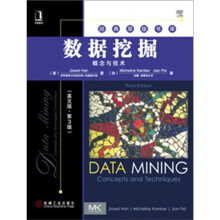Foreword to Second Edition
Preface
Acknowledgments
About the Authors
Chapter1 Introduction
Why Data Mining?
Moving toward the Information Age
Data Mining as the Evolution of Information Technology
What Is Data Mining?
What Kinds of Data Can Be Mined?
Database Data
Data Warehouses
Transactional Data
Other Kinds of Data
What Kinds of Patterns Can Be Mined?
Class/Concept Description: Characterization and Discrimination
Mining Frequent Patterns, Associations, and Correlations
Classification and Regression for Predictive Analysis
Cluster Analysis
Outlier Analysis
Are All Patterns Interesting?
Which Technologies Are Used?
Statistics
Machine Learning
Database Systems and Data Warehouses
Information Retrieval
Which Kinds of Applications Are Targeted?
Business Intelligence
Web Search Engines
Major Issues in Data Mining
Mining Methodology
User Interaction
Efificiency and Scalability
Diversity of Database Types
Data Mining and Society
Summary
Exercises
Bibliographic Notes
Chapter 2 Getting to Know Your Data
Data Objects and Attribute Types
What Is an Attribute?
Nominal Attributes
Binary Attributes
Ordinal Attributes
Numeric Attributes
Discrete versus Continuous Attributes
Basic Statistical Descriptions of Data
Measuring the Central Tendency: Mean, Median, and Mode
Measuring the Dispersion of Data: Range, Quartiles, Variance,
Standard Deviation, and Interquartile Range
Graphic Displays of Basic Statistical Descriptions of Data
Data Visualization
PixeI-Oriented Visualization Techniques
Geometric Projection Visualization Techniques
Icon-Based Visualization Techniques
Hierarchical Visualization Techniques
Visualizing Complex Data and Relations
Measuring Data Similarity and Dissimilarity
Data Matrix versus Dissimilarity Matrix
Proximity Measures for Nominal Attributes
Proximity Measures for Binary Attributes
Dissimilarity of Numeric Data: Minkowski Distance
Proximity Measures for Ordinal Attributes
Dissimilarity for Attributes of Mixed Types
Cosine Similarity
Summary
Exercises
Bibliographic Notes
……
Chapter 3 Data Preprocessing
Chapter 4 Data Warehousing and Online Analytical Processin
Chapter 5 Data Cube Technology
Chapter 6 Mining Frequent Patterns, Associations, and Correlations: Basic Concepts and Methods
Chapter 7 Advanced Pattern Mining
Chapter 8 Classification: Basic Concepts
Chapter 9 Classification: Advanced Methods
Chapter 10 Cluster Analysis: Basic Concepts and I~ethods
Chapter 11 Advanced Cluster Analysis
Chapter 12 Outlier Detection
Chapter 13 Data Mining Trends and Research Frontiers
Bibliography
Index









 缺书网
缺书网 扫码进群
扫码进群